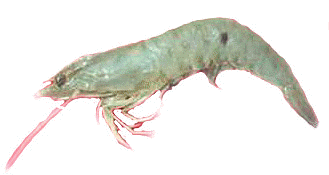|
|
|
||||||
|
Gulf White Shrimp
Penaeus setiferus
White Shrimp Identified by the United Nations' Food and Agriculture Organization as Northern White Shrimp it is also just called white shrimp and is considered one of the world's most important commercial species this shrimp sets the standard for all other shrimp, due to its consistency and familiarity. Gulf Whites are concentrated south of the Carolinas but can be found from New Jersey along the Atlantic Coast to Florida and in the Gulf of Mexico where the bulk of the harvest comes from. Shrimp are harvested May through the fall, when they are largest. Variations in shell color often cause the whites to be confused with the brown shrimp but the brown can be differentiated by the grove in the last tail segment, which is not present in the whites.
Yellowing or a bleached appearance can indicate excessive use of bisulfite: pitted or gritty shells is a result of undissolved sodium bisulfite acting on the shell. Pink discoloration in raw shrimp means the shrimp have been poorly handled. Melanosis, or black spot is the natural deterioration of the shell and meat. The shell darkens first, often forming rings, followed by the meat. Not considered a true health hazard it does however indicate poor handling. Fresh shrimp should have the aroma of fresh seawater or seaweed.
|
|||||||
|
|
|||||||

